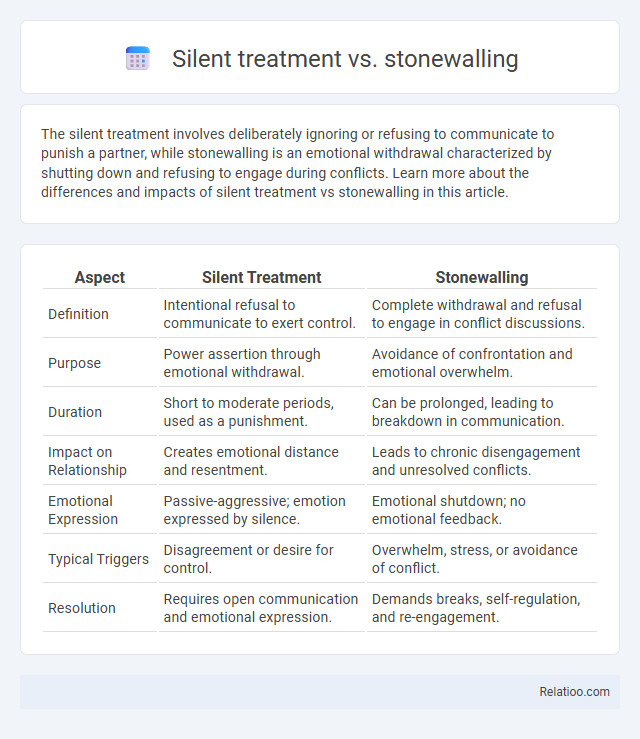The silent treatment involves deliberately ignoring or refusing to communicate to punish a partner, while stonewalling is an emotional withdrawal characterized by shutting down and refusing to engage during conflicts. Learn more about the differences and impacts of silent treatment vs stonewalling in this article.
Table of Comparison
| Aspect | Silent Treatment | Stonewalling |
|---|---|---|
| Definition | Intentional refusal to communicate to exert control. | Complete withdrawal and refusal to engage in conflict discussions. |
| Purpose | Power assertion through emotional withdrawal. | Avoidance of confrontation and emotional overwhelm. |
| Duration | Short to moderate periods, used as a punishment. | Can be prolonged, leading to breakdown in communication. |
| Impact on Relationship | Creates emotional distance and resentment. | Leads to chronic disengagement and unresolved conflicts. |
| Emotional Expression | Passive-aggressive; emotion expressed by silence. | Emotional shutdown; no emotional feedback. |
| Typical Triggers | Disagreement or desire for control. | Overwhelm, stress, or avoidance of conflict. |
| Resolution | Requires open communication and emotional expression. | Demands breaks, self-regulation, and re-engagement. |
Understanding the Silent Treatment
The silent treatment involves intentionally ignoring or refusing to communicate with someone as a form of punishment or control, whereas stonewalling is a defensive mechanism characterized by shutting down emotionally and avoiding engagement during conflicts. Understanding the silent treatment requires recognizing its role as a passive-aggressive behavior aimed at exerting power and creating emotional distance. Differentiating silent treatment from stonewalling helps address communication breakdowns and fosters healthier conflict resolution strategies.
What Is Stonewalling?
Stonewalling is a communication barrier where one partner withdraws emotionally and physically, refusing to engage in dialogue or respond during conflicts, often leaving the other person feeling ignored and frustrated. Unlike the silent treatment, which is an intentional, punitive act to exert control, stonewalling is typically a defensive mechanism to avoid conflict or overwhelming emotions. Understanding stonewalling helps you recognize patterns that hinder resolution and promote healthier communication habits.
Silent Treatment vs Stonewalling: Key Differences
Silent treatment involves deliberately ignoring or refusing to communicate to punish or express anger, often as a passive-aggressive behavior. Stonewalling occurs when one shuts down emotionally and completely withdraws from interaction, typically as a defense mechanism to avoid conflict or overwhelm. Understanding these distinctions helps you identify unhealthy communication patterns and encourages healthier conflict resolution in relationships.
Psychological Impact on Relationships
Silent treatment and stonewalling both significantly damage relationships by fostering emotional distance and mistrust. Silent treatment involves purposeful withdrawal of communication to punish or control, leading to feelings of rejection and confusion, whereas stonewalling is an emotional shutdown during conflicts that blocks resolution and escalates frustration. Both behaviors contribute to heightened anxiety, reduced emotional intimacy, and can lead to long-term relational deterioration if unaddressed.
Signs You’re Experiencing Stonewalling
Stonewalling is characterized by emotional withdrawal and refusal to engage in communication, often marked by avoiding eye contact, giving monosyllabic responses, and physically distancing oneself during conflicts. Unlike the silent treatment, which is a deliberate punishment tactic, stonewalling serves as a defensive mechanism to shut down communication and prevent emotional overwhelm. Recognizing signs of stonewalling early can help address communication breakdowns before they escalate into deeper relational issues.
Why People Use the Silent Treatment
People use the silent treatment as a defense mechanism to avoid conflict, express dissatisfaction, or gain control over a situation without direct confrontation. Stonewalling, a form of emotional withdrawal often seen in long-term conflicts, involves shutting down communication entirely, which can leave relationships stagnant and unresolved. Your challenge is to recognize these patterns early and address the underlying emotions to promote healthier communication and emotional connection.
Long-Term Effects of Emotional Withdrawal
Long-term effects of emotional withdrawal, such as silent treatment and stonewalling, can severely damage relationships by fostering resentment, decreasing trust, and impairing communication. Silent treatment involves purposeful silence to punish or control, while stonewalling is a defensive response leading to emotional disconnection. Your emotional well-being and relationship stability suffer when these patterns persist without resolution or mutual understanding.
Healthy Communication Alternatives
Silent treatment and stonewalling both involve purposeful refusal to communicate but differ in intent; silent treatment often serves as punishment, while stonewalling functions as emotional withdrawal during conflict. Healthy communication alternatives include expressing feelings openly using "I" statements, actively listening without interrupting, and taking breaks to cool down before resuming discussions. These strategies foster emotional connection, mutual respect, and effective conflict resolution in relationships.
Coping Strategies for Victims
Victims of silent treatment and stonewalling benefit from coping strategies such as setting clear communication boundaries and seeking external support from trusted friends or therapists. Developing assertive communication skills helps individuals express feelings without escalating conflict or retreating into silence. Practicing self-care and maintaining emotional resilience through mindfulness and stress-reduction techniques fosters healthier responses to emotional withdrawal and promotes overall well-being.
When to Seek Professional Help
Persistent silent treatment often signals unresolved emotional conflicts that can erode trust and intimacy, while stonewalling involves total withdrawal, blocking any form of communication and escalating relational tension. Recognizing these behaviors' impact on mental health and relationship stability is crucial; seek professional help when withdrawal patterns cause chronic distress, hinder conflict resolution, or lead to feelings of isolation and hopelessness. Therapists can facilitate communication strategies and emotional processing essential for breaking these damaging interaction cycles.

Infographic: Silent treatment vs Stonewalling
 relatioo.com
relatioo.com